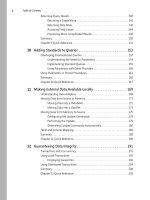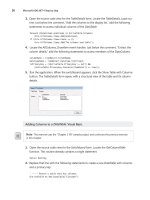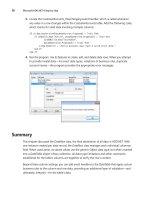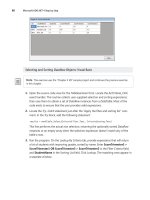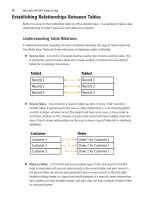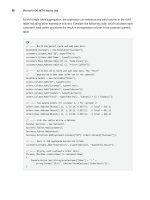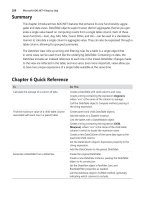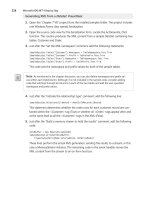Microsoft ADO .NET 4 Step by Step - p 2 pdf
Bạn đang xem bản rút gọn của tài liệu. Xem và tải ngay bản đầy đủ của tài liệu tại đây (303.5 KB, 10 trang )
x Table of Contents
Returning Query Results . . . . . . . . . . . . . . . . . . . . . . . . . . . . . . . . . . . . . . . . . . . . . 140
Returning a Single Value. . . . . . . . . . . . . . . . . . . . . . . . . . . . . . . . . . . . . . . . 141
Returning Data Rows. . . . . . . . . . . . . . . . . . . . . . . . . . . . . . . . . . . . . . . . . . . 142
Accessing Field Values. . . . . . . . . . . . . . . . . . . . . . . . . . . . . . . . . . . . . . . . . . 144
Processing More Complicated Results . . . . . . . . . . . . . . . . . . . . . . . . . . . . 146
Summary . . . . . . . . . . . . . . . . . . . . . . . . . . . . . . . . . . . . . . . . . . . . . . . . . . . . . . . . . . 150
Chapter 9 Quick Reference. . . . . . . . . . . . . . . . . . . . . . . . . . . . . . . . . . . . . . . . . . . 151
10 Adding Standards to Queries . . . . . . . . . . . . . . . . . . . . . . . . . . . . 153
Developing Parameterized Queries . . . . . . . . . . . . . . . . . . . . . . . . . . . . . . . . . . . 153
Understanding the Need for Parameters . . . . . . . . . . . . . . . . . . . . . . . . . 154
Implementing Standard Queries . . . . . . . . . . . . . . . . . . . . . . . . . . . . . . . . . 155
Using Parameters with Other Providers. . . . . . . . . . . . . . . . . . . . . . . . . . . 160
Using Parameters in Stored Procedures. . . . . . . . . . . . . . . . . . . . . . . . . . . . . . . . 161
Summary . . . . . . . . . . . . . . . . . . . . . . . . . . . . . . . . . . . . . . . . . . . . . . . . . . . . . . . . . . 166
Chapter 10 Quick Reference. . . . . . . . . . . . . . . . . . . . . . . . . . . . . . . . . . . . . . . . . . 167
11 Making External Data Available Locally . . . . . . . . . . . . . . . . . . . 169
Understanding Data Adapters . . . . . . . . . . . . . . . . . . . . . . . . . . . . . . . . . . . . . . . . 169
Moving Data from Source to Memory . . . . . . . . . . . . . . . . . . . . . . . . . . . . . . . . . 171
Moving Data into a
DataTable . . . . . . . . . . . . . . . . . . . . . . . . . . . . . . . . . . .
171
Moving Data into a
DataSet. . . . . . . . . . . . . . . . . . . . . . . . . . . . . . . . . . . . .
173
Moving Data from Memory to Source . . . . . . . . . . . . . . . . . . . . . . . . . . . . . . . . . 175
Configuring the Update Commands . . . . . . . . . . . . . . . . . . . . . . . . . . . . . 175
Performing the Update. . . . . . . . . . . . . . . . . . . . . . . . . . . . . . . . . . . . . . . . . 179
Generating Update Commands Automatically. . . . . . . . . . . . . . . . . . . . .180
Table and Column Mapping. . . . . . . . . . . . . . . . . . . . . . . . . . . . . . . . . . . . . . . . . . 186
Summary . . . . . . . . . . . . . . . . . . . . . . . . . . . . . . . . . . . . . . . . . . . . . . . . . . . . . . . . . . 188
Chapter 11 Quick Reference. . . . . . . . . . . . . . . . . . . . . . . . . . . . . . . . . . . . . . . . . . 189
12 Guaranteeing Data Integrity . . . . . . . . . . . . . . . . . . . . . . . . . . . . . 191
Transactions and Concurrency. . . . . . . . . . . . . . . . . . . . . . . . . . . . . . . . . . . . . . . . 191
Using Local Transactions. . . . . . . . . . . . . . . . . . . . . . . . . . . . . . . . . . . . . . . . . . . . . 195
Employing Savepoints. . . . . . . . . . . . . . . . . . . . . . . . . . . . . . . . . . . . . . . . . . 202
Using Distributed Transactions . . . . . . . . . . . . . . . . . . . . . . . . . . . . . . . . . . . . . . . 204
Summary . . . . . . . . . . . . . . . . . . . . . . . . . . . . . . . . . . . . . . . . . . . . . . . . . . . . . . . . . . 208
Chapter 12 Quick Reference. . . . . . . . . . . . . . . . . . . . . . . . . . . . . . . . . . . . . . . . . . 209
Table of Contents xi
Part III Entity Framework
13 Introducing the Entity Framework . . . . . . . . . . . . . . . . . . . . . . . . 213
Understanding the Entity Framework. . . . . . . . . . . . . . . . . . . . . . . . . . . . . . . . . . 213
Defining the Entity Framework’s Terms . . . . . . . . . . . . . . . . . . . . . . . . . . . 215
Understanding the Entity Framework’s Layers . . . . . . . . . . . . . . . . . . . . . . . . . . 216
Understanding the Conceptual Model . . . . . . . . . . . . . . . . . . . . . . . . . . . 217
Understanding the Storage Model . . . . . . . . . . . . . . . . . . . . . . . . . . . . . . . 217
Understanding the Model Mappings . . . . . . . . . . . . . . . . . . . . . . . . . . . . . 218
Using the Entity Framework . . . . . . . . . . . . . . . . . . . . . . . . . . . . . . . . . . . . . . . . . . 218
Building the Model . . . . . . . . . . . . . . . . . . . . . . . . . . . . . . . . . . . . . . . . . . . . 218
Generating the Objects. . . . . . . . . . . . . . . . . . . . . . . . . . . . . . . . . . . . . . . . . 220
Instantiating the Context . . . . . . . . . . . . . . . . . . . . . . . . . . . . . . . . . . . . . . . 221
Running Framework Queries . . . . . . . . . . . . . . . . . . . . . . . . . . . . . . . . . . . . 222
Summary . . . . . . . . . . . . . . . . . . . . . . . . . . . . . . . . . . . . . . . . . . . . . . . . . . . . . . . . . . 223
Chapter 13 Quick Reference. . . . . . . . . . . . . . . . . . . . . . . . . . . . . . . . . . . . . . . . . . 223
14 Visualizing Data Models. . . . . . . . . . . . . . . . . . . . . . . . . . . . . . . . . 225
Designing an Entity Framework Model . . . . . . . . . . . . . . . . . . . . . . . . . . . . . . . . 225
Using the Entity Data Model Wizard . . . . . . . . . . . . . . . . . . . . . . . . . . . . . 225
Entity Data Model Designer. . . . . . . . . . . . . . . . . . . . . . . . . . . . . . . . . . . . . 230
Working with the Mapping Details Panel . . . . . . . . . . . . . . . . . . . . . . . . . 235
Using the Model Browser . . . . . . . . . . . . . . . . . . . . . . . . . . . . . . . . . . . . . . . 240
Managing the Object Layer . . . . . . . . . . . . . . . . . . . . . . . . . . . . . . . . . . . . . . . . . . 241
Summary . . . . . . . . . . . . . . . . . . . . . . . . . . . . . . . . . . . . . . . . . . . . . . . . . . . . . . . . . . 242
Chapter 14 Quick Reference. . . . . . . . . . . . . . . . . . . . . . . . . . . . . . . . . . . . . . . . . . 243
15 Querying Data in the Framework. . . . . . . . . . . . . . . . . . . . . . . . . 245
Getting to Know Entity SQL . . . . . . . . . . . . . . . . . . . . . . . . . . . . . . . . . . . . . . . . . . 246
Writing Basic Queries . . . . . . . . . . . . . . . . . . . . . . . . . . . . . . . . . . . . . . . . . . 246
Using Literals, Operators, and Expressions . . . . . . . . . . . . . . . . . . . . . . . . 249
Grouping and Aggregating Entity Data. . . . . . . . . . . . . . . . . . . . . . . . . . . 252
Using Features Unique to Entity SQL . . . . . . . . . . . . . . . . . . . . . . . . . . . . . 254
Running Entity SQL Queries . . . . . . . . . . . . . . . . . . . . . . . . . . . . . . . . . . . . . . . . . . 256
Running Queries Using an
ObjectQuery . . . . . . . . . . . . . . . . . . . . . . . . . .
256
Running Queries Using a Provider . . . . . . . . . . . . . . . . . . . . . . . . . . . . . . . 260
Summary . . . . . . . . . . . . . . . . . . . . . . . . . . . . . . . . . . . . . . . . . . . . . . . . . . . . . . . . . . 264
Chapter 15 Quick Reference. . . . . . . . . . . . . . . . . . . . . . . . . . . . . . . . . . . . . . . . . . 265
xii Table of Contents
16 Understanding Entities Through Objects . . . . . . . . . . . . . . . . . . 267
Managing Entity Data Through Objects . . . . . . . . . . . . . . . . . . . . . . . . . . . . . . . 267
Accessing Entity Data Through Objects. . . . . . . . . . . . . . . . . . . . . . . . . . . 268
Modifying Entity Data Through Objects . . . . . . . . . . . . . . . . . . . . . . . . . . 271
Using Query Builder Methods . . . . . . . . . . . . . . . . . . . . . . . . . . . . . . . . . . . . . . . . 278
Queryable Extension Methods . . . . . . . . . . . . . . . . . . . . . . . . . . . . . . . . . . 283
Summary . . . . . . . . . . . . . . . . . . . . . . . . . . . . . . . . . . . . . . . . . . . . . . . . . . . . . . . . . . 285
Chapter 16 Quick Reference. . . . . . . . . . . . . . . . . . . . . . . . . . . . . . . . . . . . . . . . . . 285
Part IV LINQ
17 Introducing LINQ . . . . . . . . . . . . . . . . . . . . . . . . . . . . . . . . . . . . . . 289
Getting to Know LINQ. . . . . . . . . . . . . . . . . . . . . . . . . . . . . . . . . . . . . . . . . . . . . . . 289
Using LINQ with .NET Objects . . . . . . . . . . . . . . . . . . . . . . . . . . . . . . . . . . . . . . . . 291
Starting a Query with the
From
Clause . . . . . . . . . . . . . . . . . . . . . . . . . . . 293
Projecting Results with the
Select
Clause . . . . . . . . . . . . . . . . . . . . . . . . . 293
Filtering Results with the
Where
Clause. . . . . . . . . . . . . . . . . . . . . . . . . . . 295
Sorting Results with the
Order By
Clause . . . . . . . . . . . . . . . . . . . . . . . . . 296
Selecting Linked Results with the
Join
Keyword. . . . . . . . . . . . . . . . . . . . 297
Limiting the Queried Content . . . . . . . . . . . . . . . . . . . . . . . . . . . . . . . . . . . 299
Summarizing Data Using Aggregates . . . . . . . . . . . . . . . . . . . . . . . . . . . . 301
Applying Set Operations . . . . . . . . . . . . . . . . . . . . . . . . . . . . . . . . . . . . . . . 302
Summary . . . . . . . . . . . . . . . . . . . . . . . . . . . . . . . . . . . . . . . . . . . . . . . . . . . . . . . . . . 303
Chapter 17 Quick Reference. . . . . . . . . . . . . . . . . . . . . . . . . . . . . . . . . . . . . . . . . . 304
18 Using LINQ to DataSet . . . . . . . . . . . . . . . . . . . . . . . . . . . . . . . . . . 305
Understanding the LINQ to DataSet Provider. . . . . . . . . . . . . . . . . . . . . . . . . . . 305
Writing Queries with LINQ to DataSet . . . . . . . . . . . . . . . . . . . . . . . . . . . . . . . . .306
Summary . . . . . . . . . . . . . . . . . . . . . . . . . . . . . . . . . . . . . . . . . . . . . . . . . . . . . . . . . . 312
Chapter 18 Quick Reference. . . . . . . . . . . . . . . . . . . . . . . . . . . . . . . . . . . . . . . . . . 313
19 Using LINQ to Entities . . . . . . . . . . . . . . . . . . . . . . . . . . . . . . . . . . 315
Understanding the LINQ to Entities Provider . . . . . . . . . . . . . . . . . . . . . . . . . . . 315
Writing Queries with LINQ to Entities. . . . . . . . . . . . . . . . . . . . . . . . . . . . . . . . . . 316
Working with Entity and Database Functions. . . . . . . . . . . . . . . . . . . . . . 321
Working with Custom Database Functions . . . . . . . . . . . . . . . . . . . . . . . . 324
Summary . . . . . . . . . . . . . . . . . . . . . . . . . . . . . . . . . . . . . . . . . . . . . . . . . . . . . . . . . . 329
Chapter 19 Quick Reference. . . . . . . . . . . . . . . . . . . . . . . . . . . . . . . . . . . . . . . . . . 329
Table of Contents xiii
20 Using LINQ to SQL . . . . . . . . . . . . . . . . . . . . . . . . . . . . . . . . . . . . . 331
Understanding the LINQ to SQL Provider . . . . . . . . . . . . . . . . . . . . . . . . . . . . . . 332
Comparing LINQ to SQL with LINQ to Entities . . . . . . . . . . . . . . . . . . . . . 332
Understanding the Components of LINQ to SQL. . . . . . . . . . . . . . . . . . . 333
Using the Object Relational Designer. . . . . . . . . . . . . . . . . . . . . . . . . . . . . . . . . . 335
Using Custom Database Functions in Queries . . . . . . . . . . . . . . . . . . . . . . . . . . 339
Summary . . . . . . . . . . . . . . . . . . . . . . . . . . . . . . . . . . . . . . . . . . . . . . . . . . . . . . . . . . 343
Chapter 20 Quick Reference. . . . . . . . . . . . . . . . . . . . . . . . . . . . . . . . . . . . . . . . . . 343
Part V Presenting Data to the World
21 Binding Data with ADO.NET . . . . . . . . . . . . . . . . . . . . . . . . . . . . . 347
Binding Data in Windows Forms . . . . . . . . . . . . . . . . . . . . . . . . . . . . . . . . . . . . . . 347
Creating Complex-Bound Applications . . . . . . . . . . . . . . . . . . . . . . . . . . . 348
Creating Simple-Bound Applications . . . . . . . . . . . . . . . . . . . . . . . . . . . . . 351
Understanding Windows Forms Data Binding . . . . . . . . . . . . . . . . . . . . . 352
Binding Data in WPF . . . . . . . . . . . . . . . . . . . . . . . . . . . . . . . . . . . . . . . . . . . . . . . . 354
Creating Data-Bound WPF Applications . . . . . . . . . . . . . . . . . . . . . . . . . . 354
Understanding WPF Data Binding . . . . . . . . . . . . . . . . . . . . . . . . . . . . . . .360
Binding Data in ASP.NET. . . . . . . . . . . . . . . . . . . . . . . . . . . . . . . . . . . . . . . . . . . . . 362
Creating Data-Bound ASP.NET Applications. . . . . . . . . . . . . . . . . . . . . . . 362
Understanding ASP.NET Data Binding . . . . . . . . . . . . . . . . . . . . . . . . . . . .364
Summary . . . . . . . . . . . . . . . . . . . . . . . . . . . . . . . . . . . . . . . . . . . . . . . . . . . . . . . . . . 367
Chapter 21 Quick Reference. . . . . . . . . . . . . . . . . . . . . . . . . . . . . . . . . . . . . . . . . . 367
22 Providing RESTful Services with WCF Data Services . . . . . . . . . 369
Getting to Know the Service Layers . . . . . . . . . . . . . . . . . . . . . . . . . . . . . . . . . . . 369
Introducing WCF Data Services . . . . . . . . . . . . . . . . . . . . . . . . . . . . . . . . . . 369
Introducing REST . . . . . . . . . . . . . . . . . . . . . . . . . . . . . . . . . . . . . . . . . . . . . . 370
Setting Up a Data Service. . . . . . . . . . . . . . . . . . . . . . . . . . . . . . . . . . . . . . . . . . . . 371
Defining Service Rights . . . . . . . . . . . . . . . . . . . . . . . . . . . . . . . . . . . . . . . . . 375
Accessing a Data Service using REST . . . . . . . . . . . . . . . . . . . . . . . . . . . . . . . . . . 377
Querying Entities with REST . . . . . . . . . . . . . . . . . . . . . . . . . . . . . . . . . . . . . 377
Updating Entities with REST . . . . . . . . . . . . . . . . . . . . . . . . . . . . . . . . . . . . . 381
Summary . . . . . . . . . . . . . . . . . . . . . . . . . . . . . . . . . . . . . . . . . . . . . . . . . . . . . . . . . . 384
Chapter 22 Quick Reference. . . . . . . . . . . . . . . . . . . . . . . . . . . . . . . . . . . . . . . . . . 384
Index . . . . . . . . . . . . . . . . . . . . . . . . . . . . . . . . . . . . . . . . . . . . . . . . . . . . . . . . . . . . 385
xv
Acknowledgments
An open-ended thank you goes to Microsoft, not only for developing some of the products
that have kept me gainfully employed for nearly three decades, but for welcoming me into
their book-writing fold. It was also a pleasure to work again with the team at O’Reilly Media,
Microsoft’s publishing partner. Editors Russell Jones and Kristen Borg kept all the trains run-
ning on time, which wasn’t easy given the busy technical and publishing traffic. Rounding out
the group were Meghan Blanchette, Sumita Mukherji, and Adam Witwer. Thank you all.
Sahil Malik, ADO.NET expert and fellow author, has the distinction of having read through
every single word of this book looking for technical concerns. Nancy Sixsmith did the same
for the mechanics of language, grammar, and consistency. The book is richer for their
involvement.
Claudette Moore once again worked her agenting magic, somehow always managing
to make everyone on both sides of a contract happy. This book would be nothing more
than a series of discarded emails were it not for her hard work and dedication. Thank you,
Claudette, for yet another adventure.
Thanks to all my friends at Harvest, especially fellow food and movie lovers Alice, Brenda,
Andy, Suzy, Matt, Tiffany, Jeff, and Monica. Love and appreciation in heaps to my wife Maki
and my son Spencer, both of whom exude patience and care. And thanks once again to God
for making all these other acknowledgments possible in the first place.
Tim Patrick
October 2010
xvii
Introduction
ADO.NET is Microsoft’s core data access library for .NET developers, and is the heart of many
data-centric technologies on the Windows development platform. It works with C#, Visual
Basic, and other .NET-enabled languages. If you are a .NET developer looking to interact with
database content or other external data sources, then ADO.NET is the right tool for you.
Microsoft ADO.NET 4 Step by Step provides an organized walkthrough of the ADO.NET li-
brary and its associated technologies. The text is decidedly introductory; it discusses the
basics of each covered system, with examples that provide a great head start on adding data
features to your applications. While the book does not provide exhaustive coverage of every
ADO.NET feature, it does offer essential guidance in using the key ADO.NET components.
In addition to its coverage of core ADO.NET library features, the book discusses the Entity
Framework, the LINQ query system, and WCF Data Services. Beyond the explanatory content,
each chapter includes step by step examples and downloadable sample projects that you can
explore for yourself.
Who Is This Book For?
As part of Microsoft Press’s “Developer Step By Step” series of training resources, Microsoft
ADO.NET 4 Step by Step makes it easy to learn about ADO.NET and the advanced data tools
used with it.
This book exists to help existing Visual Basic and C# developers understand the core con-
cepts of ADO.NET and related technologies. It is especially useful for programmers looking
to manage database-hosted information in their new or existing .NET applications. Although
most readers will have no prior experience with ADO.NET, the book is also useful for those
familiar with earlier versions of either ADO or ADO.NET, and who are interested in getting
filled in on the newest features.
Assumptions
As a reader, the book expects that you have at least a minimal understanding of .NET devel-
opment and object-oriented programming concepts. Although ADO.NET is available to most,
if not all, .NET language platforms, this book includes examples in C# and Visual Basic only. If
you have not yet picked up one of those languages, you might consider reading John Sharp’s
Microsoft Visual C# 2010 Step by Step (Microsoft Press 2010) or Michael Halvorson’s Microsoft
Visual Basic 2010 Step by Step (Microsoft Press 2010).
With a heavy focus on database concepts, this book assumes that you have a basic under-
standing of relational database systems such as Microsoft SQL Server, and have had brief
xviii Microsoft ADO.NET 4 Step by Step
exposure to one of the many flavors of the query tool known as SQL. To go beyond this
book and expand your knowledge of SQL and Microsoft’s SQL Server database platform,
other Microsoft Press books such as Mike Hotek’s Microsoft® SQL Server® 2008 Step by Step
(Microsoft Press, 2008) or Itzik Ben-gan’s Microsoft® SQL Server® 2008 T-SQL Fundamentals
(Microsoft Press, 2008) offer both complete introductions and comprehensive information on
T-SQL and SQL Server.
Organization of This Book
This book is divided into five sections, each of which focuses on a different aspect or technol-
ogy within the ADO.NET family. Part I, “Getting to Know ADO.NET,” provides a quick over-
view of ADO.NET and its fundamental role in .NET applications, then delves into the details
of the main ADO.NET library, focusing on using the technology without yet being concerned
with external database connections. Part II, “Connecting to External Data Sources,” continues
that core library focus, adding in the connectivity features. Part III, “Entity Framework,” in-
troduces the Entity Framework, Microsoft’s model-based data service. Another service layer,
LINQ, takes center stage in Part IV, “LINQ.” Finally, Part V, “Presenting Data to the World,”
covers some miscellaneous topics that round out the full discussion of ADO.NET.
Finding Your Best Starting Point in This Book
The different sections of Microsoft ADO.NET 4 Step by Step cover a wide range of technolo-
gies associated with the data library. Depending on your needs and your existing under-
standing of Microsoft data tools, you may wish to focus on specific areas of the book. Use
the following table to determine how best to proceed through the book.
If you are Follow these steps
New to ADO.NET development, or
an existing ADO developer
Focus on Parts I and II and on Chapter 21 in Part V, or read
through the entire book in order.
Familiar with earlier releases
of ADO.NET
Briefly skim Parts I and II if you need a refresher on the core
concepts.
Read up on the new technologies in Parts III and IV and be
sure to read Chapter 22 in Part V.
Interested in the Entity Framework Read Part III. Chapter 22 in Part V discusses data services built
on top of Entity Framework models.
Interested in LINQ data providers Read through the chapters in Part IV.
Most of the book’s chapters include hands-on samples that let you try out the concepts just
learned. No matter which sections you choose to focus on, be sure to download and install
the sample applications on your system.
Introduction xix
Conventions and Features in This Book
This book presents information using conventions designed to make the information read-
able and easy to follow.
In most cases, the book includes separate exercises for Visual Basic programmers and
Visual C# programmers. You can skip the exercises that do not apply to your selected
language.
Each exercise consists of a series of tasks, presented as numbered steps (1, 2, and so on)
listing each action you must take to complete the exercise.
Boxed elements with labels such as “Note” provide additional information or alternative
methods for completing a step successfully.
Text that you type (apart from code blocks) appears in bold.
A plus sign (+) between two key names means that you must press those keys at the
same time. For example, “Press Alt+Tab” means that you hold down the Alt key while
you press the Tab key.
A vertical bar between two or more menu items (e.g. File | Close), means that you
should select the first menu or menu item, then the next, and so on.
System Requirements
You will need the following hardware and software to complete the practice exercises in this
book:
One of Windows XP with Service Pack 3 (except Starter Edition), Windows Vista with
Service Pack 2 (except Starter Edition), Windows 7, Windows Server 2003 with Service
Pack 2, Windows Server 2003 R2, Windows Server 2008 with Service Pack 2, or
Windows Server 2008 R2
Visual Studio 2010, any edition (multiple downloads may be required if using Express
Edition products)
SQL Server 2008 Express Edition or higher (2008 or R2 release), with SQL Server
Management Studio 2008 Express or higher (included with Visual Studio, Express
Editions require separate download)
Computer that has a 1.6GHz or faster processor (2GHz recommended)
1 GB (32 Bit) or 2 GB (64 Bit) RAM (add 512 MB if running in a virtual machine or SQL
Server Express Editions; more for advanced SQL Server editions)
3.5GB of available hard disk space
5400 RPM hard disk drive

